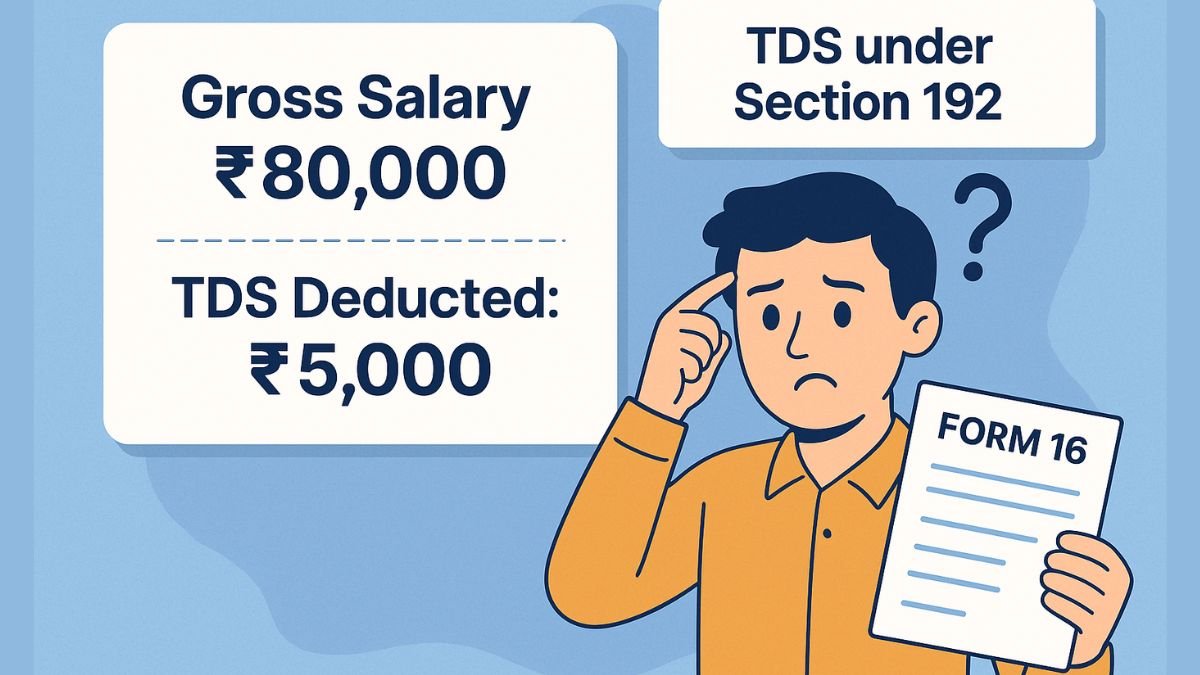
When we hear the term TDS (Tax Deducted at Source), one of the first sections that applies to most salaried individuals in India is Section 192 of the Income Tax Act. This section governs the rules for deducting income tax directly from salary payments. It applies to both private & public sector employees and ensures the timely collection of income tax by the government.
What Is Section 192 of the Income Tax Act?
Section 192 deals with the TDS on salary paid to an individual by an employer. It mandates that tax shall be deducted at source at the time of actual payment of salary, not at the time of accrual. That means if your employer pays your salary on the 1st of every month, the tax is deducted on that very date.
Unlike other TDS sections that have fixed rates, TDS under Section 192 is calculated based on applicable income tax slab rates after adjusting exemptions and deductions allowed under the Income Tax Act.
Applicability of Section 192
This section applies to all employers who are making salary payments to:
- Individuals
- Hindu Undivided Families (HUFs), and
- Association of Persons (AOPs), if applicable under employment.
It doesn’t matter whether the employer is a company, a partnership firm, or a government department. If salary is being paid, Section 192 of the Income Tax Act is applicable.
The TDS deduction under Section 192 begins only when the estimated income of the employee exceeds the basic exemption limit, which is:
- ₹2.5 lakhs for individuals below 60 years
- ₹3 lakhs for senior citizens (60–79 years)
- ₹5 lakhs for super senior citizens (80 years)
How TDS Is Calculated Under Section 192
Unlike fixed-rate TDS under other sections, Section 192 TDS rate depends on the employee’s total taxable income. Here's the step-by-step process:
- Calculate gross salary.
- Apply deductions like HRA, standard deduction (₹50,000), and professional tax.
- Apply deductions under Section 80C (PF, LIC), 80D (medical insurance), etc.
- Determine taxable income.
- Apply applicable tax slab rates.
- Divide the tax amount over the remaining months of the financial year for monthly deduction.
Section 192 of the Income Tax Act with Example
Let’s understand with a simple example:
Mr. Raj earns a gross annual salary of ₹8 lakhs. He claims:
- Standard deduction: ₹50,000
- Section 80C investments: ₹1,50,000
- Health insurance (Section 80D): ₹25,000
Taxable income = ₹8,00,000 - ₹50,000 - ₹1,50,000 - ₹25,000 = ₹5,75,000
Tax as per slab rates for FY 2023–24 = Approx. ₹20,000 (after rebate, cess)
If Raj has 10 months left in the year, his TDS per month = ₹2,000
Section 192 of the Income Tax Act PDF and Historical Data
This section has been part of the Income Tax Act since 1961 and has evolved with amendments each financial year. If you want to download the Section 192 of Income Tax Act PDF, it’s available on the official incometaxindia.gov.in site. There, you can explore details from: "
- Section 192 of the Income Tax Act 2015–16
- Section 192 of the Income Tax Act 2020–21
- Section 192 of the Income Tax Act 2022–23
- Section 192 of the Income Tax Act 2023–24
- Section 192 of the Income Tax Act 2024–25
These reflect changes in slab rates, surcharge, rebate, & exemption limits over time.
Key Differences Between Section 192 and Other TDS Sections
|
Section |
Applies To |
TDS Rate |
Threshold |
|
192 |
Salary |
Slab Rate |
Based on salary |
|
194C |
Contractors |
1%-2% |
₹30,000/₹1 lakh |
|
194J |
Professional Services |
10% |
₹30,000 |
|
194Q |
Purchase of Goods |
0.1% |
₹50 lakh |
Section 192 is unique as it is the only section where TDS depends on the income slab and not a fixed percentage. "
Section 192(2A), 192(2B), and Employer Declarations
Under sections 192(2A) and 192(2B), employees are allowed to declare other income (like rental or interest income) & deductions (like home loan interest, LIC, ELSS) to the employer for TDS calculation.
This helps in:
- Lowering monthly TDS
- Avoiding year-end tax surprises
- Managing advance tax efficiently
Final Thoughts
Section 192 of the Income Tax Act is one of the most commonly used & misunderstood provisions among salaried individuals. If you're wondering how TDS on salary is calculated, this is the section you need to understand.
To summarise:
- Section 192 deals with tax deducted at source (TDS) on salary.
- Tax shall be deducted at source at the time of actual payment of salary.
- Employees should declare investments & deductions properly to optimise TDS.
- Employers must ensure timely & correct deductions to avoid penalties. "
If you're a salaried employee, now is a good time to revisit your declarations and plan accordingly!











